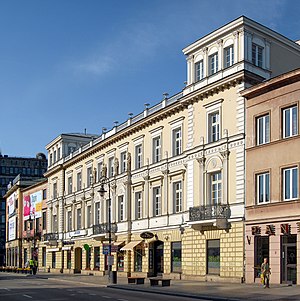Kossakovsky Palace
| Kossakovsky Palace | ||
|---|---|---|
|
From the Krakow suburbs |
||
| Creation time : | 1784 | |
| Castle type : | palace | |
| Conservation status: | Reconstructed | |
| Place: | Warsaw | |
| Geographical location | 52 ° 13 '56 " N , 21 ° 1' 11" E | |
|
|
||
The Kossakowski Palace (Polish: Pałac Kossakowskich ) is located in the center of Warsaw at ul. Nowy Świat (No. 19) and thus on the historical part of the Royal Route . Despite its location in Nowy Świat , the neo-renaissance city palace was one of the most magnificent residences in Warsaw in the 19th century.
history
In 1780, the wealthy couple Izaak (a silk merchant who came from a Berlin Huguenot family) and Marianna Ollier bought the property from August Kazimierz Sułkowski. They had a classicist , one-story palace built here around 1784 , which, in addition to a central projectile, had two side projections with attached belvederes. The design for the building probably came from Ephraim Schröger .
The heirs of Ollier sold the palace in 1848 to the large landowner Władysław Pusłowski, who commissioned Enrico Marconi to renovate the property in 1849. The entire main building - located on the street - was raised by one floor, including the belvederes on the side projections. Only the central projection was not raised and now ended (without gable) on the second floor. In 1851 this central projection was crowned with stone sculptures of the muses Klio , Thalia , Urania and Erato made by Paweł Maliński . The entire facade was designed in the style of the Italian High Renaissance. Korinthische Pilaster affiliated in the vertical, the roof had a as balustrade configured attic . To the rear, the palace was connected with three outbuildings at right angles.
Kossakowski family
As early as 1853, Pusłowski sold his residence to Aleksandra Kossakowska , whose husband Stanisław Szczęsny had previously been master of ceremonies at the royal Polish court and was an art lover and collector. In 1858 the couple fundamentally rebuilt the interior of the palace based on designs by Francesco Maria Lanci . The ballroom and the picture gallery (in one of the outbuildings) were particularly splendidly furnished. On March 4, 1859, the newly designed residence was inaugurated with a large ball. In 1865 the palace was given to the son of Kossakowska, Stanisław Kazimierz. From 1874 he organized literature evenings in the building on Fridays. Władysław Podkowiński set up his studio in one of the two Belvedere . After the death of Stanisław Kazimierz Kossakowski, the palace was converted into a tenement house by his heirs in 1905 and slowly deteriorated.
In 1911/12, a closed ice rink, the “Palais de Glace”, was built in the back yard area under the direction of Stefan Szyller . As the facility did not pay off, a roller skating rink was set up instead in the palace's former ballroom. In the interwar period , the “Colosseum” cinema was located here. In 1930 the Kossakowski community of heirs sold the property to the Warsaw Insurance Company (Polish: Warszawskie Towarzystwo Ubezpieczeń ).
War and Post War
The building was badly damaged in the battle for Warsaw in 1939. It was then almost completely destroyed in 1944 as part of the fighting over the Warsaw Uprising . The Swedish company ASEA financed the reconstruction of the palace in 1946, which was completed in 1949. But that only affected the core building, not the rear auxiliary buildings. Mieczysław Kuźma made the draft for the reconstruction . In 1968 the state took over the building and made it available to the Polish diplomatic service; In 1972 the sculptures of the muses that had been missing until then were reinserted. There is currently a trendy Warsaw restaurant (“Sense”) and a cafeteria (“Coffee Heaven”) on the ground floor, and offices on the upper floors.
See also
Web links
- Detailed information and historical recordings at Warszawa1939.pl (in Polish)
- Brief information from Warsawtour.pl (accessed on January 14, 2012)
- Brief information on the website of the City of Warsaw (in Polish)
literature
- Julius A. Chroscicki and Andrzej Rottermund, Architectural Atlas of Warsaw , 1st edition, Arkady, Warsaw 1978, p. 180
- Tadeusz S. Jaroszewski, Palaces and Residences in Warsaw , Interpress Publishing, ISBN 83-223-2049-3 , Warsaw 1985, pp. 60 ff.



